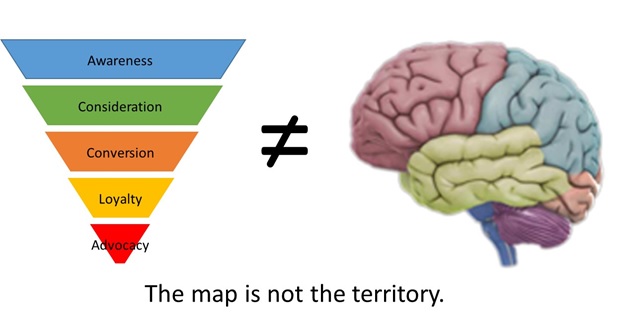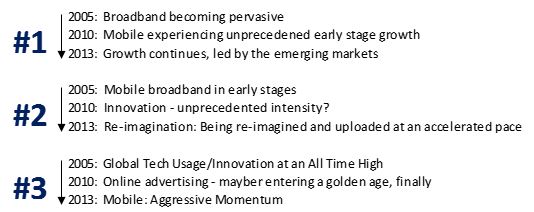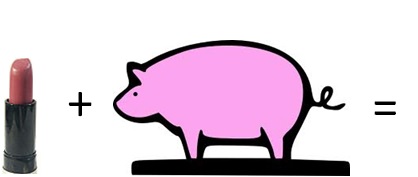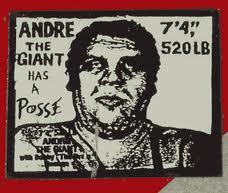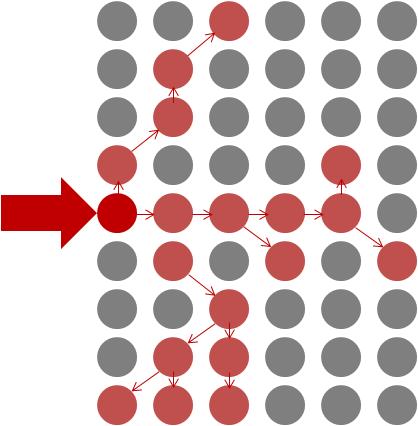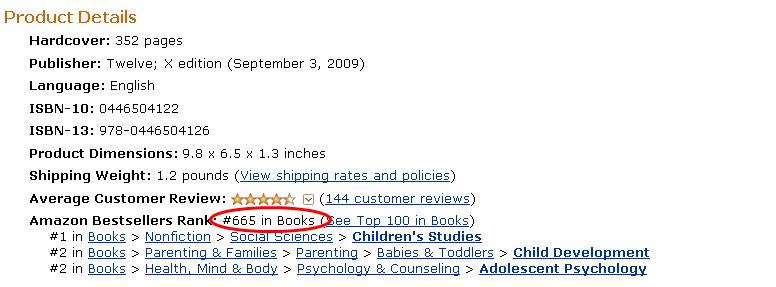Don’t Confuse Your Funnel With Reality
May 28, 2014 Industry News, Marketing, Marketing And Advertising Analytics, Optimization, Search Analytics, Web Analytics
Models are supposed to make it easier to see useful patterns, but if you devote enough time to using them you can forget you are looking at a simplified view of reality and not reality itself. The marketing funnel is a great example of how this can happen.
When you are trying get a holistic view of your marketing plan, it is often helpful to segment the audience according to where they are on the path from never having heard of your brand to the end state of buying your product. It can make things clearer. Let’s say you have done some analysis of the buying process for your product and you have found that people move through it like this:
Let’s further say your numbers say that the conversion rates for a given month look like this:
The numbers indicate that once someone is researching your product you have a really good chance of making them a customer. Depending on your cost per acquisition and the value of your product, you’d probably want to step up your efforts to drive them to your site.
Would that still be your conclusion if you knew that:
The list of complicating factors could go on and on. The point is, you are looking at a model. Don’t forget there is a particularly complicated reality behind any marketing model: the mind of the buyer.
Lying Is Not Good Marketing
May 13, 2014 Industry News, Integrity and Marketing, Marketing, Marketing And Advertising Analytics
The future of your brand – whether your marketing is online, offline, DR, branding, whatever – the survival of it depends on one key thing.
It is not big data or better metrics. It is not futuristic ad formats. It is not social media.
It is resisting the temptation to mislead people to make money. In other words, not lying.
The Ad Business press has been recommending something like this, but using the word “authenticity”. This sounds too much like Stephen Colbert’s “truthiness”, or like George Burns when he said, “Sincerity – if you can fake that, you’ve got it made.”
The fact of the matter is that, while the absolute truth is not determinable in any way that satisfies philosophers, sane people know when they are lying. That is why they work so hard at legitimizing their lies, substituting the idea of the legally permissible for the facts as they know them to be. In marketing, that ultimately results in: bad customer experiences, consumer cynicism, dissatisfied customers, jaded employees, and bad long-term business results. Lying is a short-term ploy to boost sales that ultimately kills sales by debasing your brand.
What alternatives are there to misleading offers, irrelevant images, and fast-talking copy?
How about:
1. What you could do to make your product better.
2. What you could do to make your customer experience better.
3. What you could do make your value proposition unbeatable.
4. What you could do to build customer loyalty.
Meekerology: Trending the Trender
Jan 2, 2014 Industry News, Marketing And Advertising Analytics, Web Analytics, Web Business Trends
“The future ain’t what it used to be.” – Yogi Berra
Every year about this time a barrage of “Top N” lists is unleashed, predicting what will be happening in the coming year. I think of the genre as a listicle wrapped in an article. Check it out – look on Google right now. A lot of them will be junk, and many are more or less copies of one another (sometimes attributed, sometimes not).
By contrast, the presentations of Mary Meeker (of Kleiner Perkins Caufield & Byers) are a treasure trove of recent digital history. I Googled them and found decks going back to 2005.
Looking back at how her top trends have evolved over the last eight years paints a quite a picture. The top item in 2005 was broadband penetration. The story morphs from adoption to portable always-on access by 2010, and by 2013 ecommerce – once dismissed as snake oil – is now the engine of global innovation and economic growth.
Take a look at how the first three bullet points in Mary Meeker’s decks have shifted from 2005 to 2010 to now:
From a device perspective, the focus has shifted from PCs and laptops, to smartphones, to tablets, and next to wearables and the “Internet of Things”.
The devices, though, are taking a back seat to the integration of the technology into our lives, and an ongoing explosion of ways to take advantage of its capabilities in all aspects of our lives.
Mobile changes ranks over the years, and goes from “early-stages” in 2005, to “unprecedented early-stage growth” in 2010, to “Aggressive Momentum”. The Meeker lists also show consistently ramping pace of innovation and “re-imagination”(which, to me, is a nicer word for disruption).
That’s Nice. But What Does This All Mean For Digital Marketing?
My informal Meekerological forecast says this:
1. Mobile is going to continue to increase in importance
If you believe Mary, then your number 1 takeaway should be that if you aren’t playing in mobile and tablets, then you are missing out on a massive trend. People aren’t just checking email and Facebook on mobile devices – they are now doing some serious e-commerce there.
2. Content marketing HAS to happen if you want to keep your constituency alive
We cannot all be content parasites. People get bored with me-too links to the seven original articles on the Web this week. UGC (user-generated content) is okay for some things – like finding out what people like ourselves think about a new movie or book or product, but day to day, people are starved for researched, curated, creative, non-amateur content. This is a golden opportunity to connect with your audience.
3. Big Data: Look into it, learn it, use it (but PLEASE stop calling it that)
Don’t search for latent patterns (e.g., people with curly red hair who enjoy Scrabble are your most efficient audience), which are usually subtle in impact, if you are not already exploiting commonsense first-order data effects.
4. Social, social, social
Increased mobile access seems to be manifested in sharing more things in more ways on more occasions. If that is where your customers are, then shouldn’t you, your messages, and your content be there too? Now that Congress is thinking about taxing advertising, other ways of spreading the word will be even more attractive.
5. Master the channels that your customers use
Do not tweet or build a Facebook app because you think it is the way to be modern. Do these things because that is where your customers are spending their time and you can connect with them and influence them particularly well in those channels.
Optimization vs. Improvement
May 7, 2013 Industry News, Marketing And Advertising Analytics, Optimization, Statistics
The word “optimization” can be used to refer to a mathematical technique for selecting the best combination of controllable factors to maximize the value of an outcome or dependent variable. It can also be a fancy substitute for the word “improvement”, used to project the impression you are applying some kind of mathematical rigor, when in fact you are not.
This entire post may sound like nitpicking, but there is a real issue at stake.
The main difference is this:
– If you are collecting data to map out the entire feasible space of options, then picking the best solution, you are doing “optimization”.
– If you are trying two or three of something, and then picking the winner, you are doing “improvement by trial and error”.
“Optimization” leaves you with some assurance that you have left no improvement on the table. “Improvement by trial and error” may deliver value, but without a sense of whether there are further gains available.
In the realm of marketing analysis, this distinction is further tangled by the fact that there is no way to actually map out all possible creative executions, all the possible ways to deliver them to an audience (unless you believe all the good ideas have been done already, in which case you need historians and not creatives.)
So, when someone sells you creative optimization using a multivariate testing engine that automatically spits out thousands of combinations of a background image, a headline, a call to action and a button to click, you may think you are doing real optimization, but that is true only if your collection of copy bits and graphic elements represents the whole feasible range of creative executions and not just what someone could crank out in a week or so. That, IMHO, is not likely. It is really precision masquerading as accuracy or – put differently – marketers opting for the easily quantifiable to the exclusion of the extremely effective.
Not all marketing problems are best approached via formal optimization – particularly those where creative execution is a critical variable. But it is possible to apply good test design and measurement to understand when something works better than what we are currently doing and when it does not. Just don’t call that “optimization” – that is almost like lying.
How Not To Do An A/B Test
Oct 12, 2012 Industry News, Marketing And Advertising Analytics, Optimization, Search Analytics, Statistics, Web Analytics
There are a large number of ways to make a hot mess out of an A/B test. Here are five:
1. Don’t Measure Conversions
“We don’t have time to set up conversion tracking. Let’s just decide based on click rate.”
This is a terrible idea. Clicking and converting are two very different things, and click rates are often not correlated with conversion rates. For example, I click on pictures of Ferraris, because I like to look at Ferraris, but you can ask all my friends – I have never bought a Ferrari. I have bought a Mazda, a Toyota, a Datsun and a Ford Maverick. You can show me a Ferrari if all you want is clicks, but show me something I might actually buy if you want conversions.
2. Don’t Do Any Test Size Calculations
Ten minutes of work could tell you that you won’t have enough data to read your test even if you ran it for two years. Are you sure you can’t afford some time to do a Google search for “A/B Test Calculator” and plug some numbers into a form?
I’ll save you even more time, use this one: ABBA
3. Stick With Your Test Size Calculations No Matter What Happens
The test size calculations you did were based on some assumptions: confidence level, the magnitude of the difference you wanted to be able to detect, and the expected performance of the baseline or control. After you’ve run the test for a while you can begin to see where reality and your assumptions have parted ways. What should you do? Most people do repeated significance calculations and quit when they are satisfied with the significance. If you do this, you’ve spent too much time and opportunity cost on your test. You could have quit sooner, had you known about Anscombe’s Stopping Rule, which uses an approach called regret minimization, and you would actually end up with more conversions.
Check it out: A Bayesian Approach to A/B Testing
4. Don’t Think About Gating
What is gating?
Let’s say you have two different versions of a page: Version A and Version B. Let’s say your plan is to rotate them randomly. Let’s say your site and your content are such that most people come to the site repeatedly, say two to six times per week. If you are rotating Version A and Version B completely at random, then most of your users are going to see a blended treatment. This will reduce the effects of your test. To fix this, you want to make the version a person sees “sticky’ so one group sees only Version A during the test and the other group sees only Version B. That way each group sees a consistent treatment and you will see more of an effect (assuming the differences between A and B are substantial enough).
This is called “gating” and is done by randomly assigning new visitors (people with no gating in their cookie) to Version A or B, and then storing that in their cookie so that the next time they will see the same version.
5. Conclude That Your A/B Testing Result is Actually Optimal
An A/B test picks one “best” version for everyone. But isn’t it possible that there are some people in the audience who’d respond best to Version A and others who’d respond best to Version B? For that, you’d need to be able to collect lots of data about what kinds of users respond to the different options, and then you’d need a way to target the two versions at the audiences they work best with. Fortunately such tools exist.
Check out the toolset I work with every day at [X+1]: [X+1] Home Page
When Thomas Friedman Notices, Something Must Really Be Going On
Jun 27, 2012 Industry News, machine learning, Marketing And Advertising Analytics, Statistics
A couple of months ago, a bunch of us at [x+1] started taking a free online course in machine learning taught by Stanford University’s Andrew Ng. It was an offer difficult to refuse: a company called Coursera is offering top-flight university courses for free, and Andrew Ng’s class is among them. Thomas Friedman’s recent New York Times column offered up Dr. Ng’s experience as emblematic of a larger trend in higher education (i.e., online alternatives to an increasingly costly option for young students), but what caught my eye were the numbers.
Ng was quoted in the article:
“I normally teach 400 students,” Ng explained, but last semester he taught 100,000 in an online course on machine learning. “To reach that many students before,” he said, “I would have had to teach my normal Stanford class for 250 years.”
This blew my mind. I have been doing this kind of work for half my life, and I have never run into a group of more than 200-300 of us at one time – and that was at a SAS convention in Vegas! Now 100,000 people are taking this one course per semester!!!! I was immediately imagining a future when:
1. People at parties would understand my answer to “What do you do?” without my having to offer a hyper-simplified reduction (“statistical marketing” is the best I have come up with).
2. It will be easier to find talent in this business (good for building teams, maybe not so good for salaries).
3. A world where the business people I work with have some kind of reasonable sense of what you can and can’t do with statistics.
Realistically, these numbers need to be discounted for people dropping off because of lack of time, interest, and perhaps aptitude. However, this does point to a major trend in analytics: business people are increasingly aware that they need modern data analytics to function in the new, data-rich digital world. Given the tendency of digital entrepreneurs to flog us with buzzword-laden feather merchantry, we can also be assured of 5-10 years of “big data” blather, but I guess mimicry is the cost of increasing demand for our field.
Go With The Flow (Diagram) – Gettin’ Sankey With It
Jan 13, 2012 Industry News, Marketing And Advertising Analytics, Web Analytics
If you are looking for a great way to visualize the way traffic is flowing through a website, try a Sankey diagram, which is a kind of flow diagram where the width of the flow arrows is shown proportionally to the flow quantity. It is a very quickly understood way of communicating what can be complex information.
Like many other people, I had my first taste of Sankey in Edward Tufte’s “The Visual Display of Quantitative Information”, which featured a diagram by Charles Joseph Minard that illustrated Napoleon’s disastrous march to (and from) Moscow. Arrows on the map of Europe showed the Napoleon’s route, while the width of the arrows indicated the (disastrously shrinking) size of his Army.
If you want to try this technique out on your website, read more about Google Analytics’ flow visualization here. It is a dynamic, Sankey-like diagram that you can navigate to get an intuitive visual grasp of how traffic is moving through a site.
Measurement is No Substitute for Thinking BIG
Oct 7, 2010 Marketing And Advertising Analytics, Statistics, Web Analytics
Whether you are doing SEO for a site or running paid search for one, running display ad campaigns or social media, everyone is trying to measure the same thing – they are trying to find evidence that what they are doing is worth the money and time it costs.
There is a point of view (not necessarily mine) that says: If you have to do a complicated analysis to see the effect of a marketing initiative, then it wasn’t very effective. There is some truth there. It is easier, statistically speaking, to measure a BIG marketing impact than it is to measure a small one.
Reality is complicated, though. If you are engaged in “filling the funnel”, you want to know how how that translates – in the long run – into actual sales. However, unless you can wait until there is data for the whole decision and purchase process to make any decisions about how to manage the campaign and the channel, then you will have to go with measuring some intermediate impact.
It is almost a certainty that enough other things will happen to impact sales in the time between your funnel-filling campaign and the sales it ultimately leads to. Enough things to muddy the waters about how much of of your success (or lack of it) came from the lagged effect of your funnel-filling efforts. Unless the effect is big.
This is not to say that measurement is not necessary for early-stage marketing activities, but to say that you have to apply some common sense to your measurement problems, and one bit of marketing common sense is this: think BIG. Now think BIGGER. You should always be aiming to have a big effect – you won’t always succeed in a huge way, but it should not be for lack of trying.
Here’s an idea: Every time you create a campaign, a marketing tactic, an ad, you should at least TRY to do some creative thinking that taps into one or more sources of disproportionate (on the BIG side) response. What well-defined and targetable group would have a peculiar affiinity with your message and your product? What would make them want to know more NOW, click NOW, buy NOW?
What does that have to do with measurement? Two things:
1. Even if your BIG idea doesn’t work, you are actually testing a hypoethesis and so you have gotten just a little smarter.
2. Your goal is to produce impact so BIG that you don’t even really need to measure it to know that the effort was ROI-positive. (But you are measuring it anyway, so you can explain why the next one needs to have a bigger budget!) And – falling short of a really BIG goal will get you to positive business results more often than falling short of modest goals.
Tags: Andre the Giant, BIG, Campaign Measurement, Marketing Analytics, Online Advertising, Scale of Marketing Effects, SEO, Social Media, Statistics
The “Death of Marketing” Has Been Announced Prematurely
Aug 23, 2010 Industry News, Marketing And Advertising Analytics, Social Media, Web Analytics
Has there been a fundamental change in how people think about and buy goods and services? Is old-school marketing dead?
According to the recently-minted orthodoxy of social media, marketing is being transformed, and we are moving from the Age of Push to the Era of the Conversation. The Don Drapers of the world, they say, will now have to play the new way, find new jobs or become hobos. Participation in a conversation is voluntary, per the new theory, meaning marketers can’t unilaterally control conversations and so now must learn to communicate differently with the people in the marketplace.
WHAT HASN’T CHANGED
Marketing Has Always Been A Conversation – Marketers Just Haven’t Recognized It Until Now
There is an important truth here – much of the conversation about brands and products is intra-customer, and doesn’t involve the marketer at all. This has always been the case, but it just has not been as observable until it started happening online.
Audiences Have Always Been Able to Walk Away
Audiences have always asserted more control over the “conversation” than marketing models have admitted. People have been fast-forwarding and channel-surfing through television ads since they figured out which remote control buttons to use. Since the very birth of mass media, admen and their clients have been solving and re-solving the problem of how to entice an audience to listen to their stories instead of wandering off to grab something from the refrigerator.
Propaganda Still Works
Working against this is has always been the fact that (as psychological experiments have shown) repeated messages have an influence on peoples’ perceptions and behavior even if they are skeptical or not paying full attention, and even if they are aware they are being ‘sold’.
WHAT HAS CHANGED
The Emergence of Social Media
Thanks to social media lowering the bar for what constitutes a relationship, people are regularly engaging in communication with a wider circle of casual or low-involvement contacts.
Conversations are Observable and Trackable
We can find out what people are saying about brands and our products (at least when they happen in online social media). These conversations can assert a great deal of influence on buying behavior.
Advertisers and Marketers can Participate in the Conversation
Marketers can, when they decide it is to their advantage, participate in these conversations and assert some influence on the the agenda and the messages
Advertisers and Marketers can START the Conversation
Marketers can initiate conversations, and they can provide the platform or venue for these conversations to take place. However, the the attempt can backfire. Conversations can and will change locations if a community gets the sense that there is excessive censoring or propagandizing.
SO?
So, things have changed, but not that much. People still need to buy things, they still need to decide what to buy and where to buy it. It’s just that now, people increasingly use social media (among other channels) to get information about products and services they are considering. Social networks have always been influential, but now they are pervasive, instantaneous, and measureable. So you shouldn’t ignore social media, you should listen to and participate in it. That’s all.
Tags: Death of Marketing, Don Draper, Facebook, hobo, LinkedIn, listening, Listening programs, marketing, Marketing as Conversation, Social Media, Twitter
The Digital Nervous System
Aug 20, 2010 Industry News, Marketing And Advertising Analytics, Statistics, Web Analytics
The web can function like a giant extension of the human nervous system. Like a spider at the center of a giant global web, you can collect and observe streams of data coming from all over the digital expanse: searches, tweets, forums, blogs, newspaper and magazine sites, press releases, Facebook and LinkedIn. Each time someone looks for or mentions your company or your product you are alerted, and you can choose in that moment to respond to it, ignore it or wait until you have more information.
Does this sound like anything you are doing now? Someone should be doing this for your company, because marketing has increasingly become an ongoing series of conversations (whether you participate in the conversation or not).
EXPERIMENT: DETECTING INSTANT RESPONSE TO MEDIA WITH THE INTERNET
There are several national TV shows that frequently have book authors as guests (the Daily Show, The Colbert Report, The Today Show, Good Morning America). The next time you find yourself in front of one of these shows when an author is on plugging their book, try the following experiment (this will work best with a show with a national audience):
1. Fire up your laptop and go to amazon.com
2. Search in the Books category for the title of the book the author is plugging on the show you are watching
3. Click to the Amazon page for that book.
4. Scroll down past the synopsis and the reviews to the section labelled Product Details. It should look something like this:
The number I have circled is the book’s current sales rank on Amazon.
5. Every few minutes while the author is on the show and for a while after that (until you bore of this experiment), hit function key f5 to refresh the page and watch what happens to the book’s sales ranking.
The rank should get better – in real time – as you are sitting there. I have done this several times when my brother-in-law has done TV appearances to promote his books, and it is amazing. Once he was on Oprah Winfrey and we saw the sales rank improve precipitously from 20-something into the top 10 while he was being interviewed.
Now imagine all the other analogous information streams there are available on the internet. If you could get the monitoring automated, just think of how quickly you will know exactly what the world thinks of your new site, your new ad campaign, your new product. Just think of what you’d be missing by NOT knowing.
EXTRA CREDIT EXPERIMENT #1 – THE TWITTER BUMP
In between rank checks you should do check in on Twitter searches for the author’s name and the book’s name. These should also pop during the author’s TV appearance.
EXTRA CREDIT EXPERIMENT #2 – THE GOOGLE BUMP
After a day or so you should go to Google Trends and see what happened to searches for the author’s name and the book’s name. These should’ve spiked on the day the author did the TV appearance. Google Trends doesn’t provide much flexibility about getting more granular (in time) data in a more real-time way, and it looks like the beta for Google Insights for Search has a latency of a couple of days.
GOOGLE EPIDEMIOLOGY – WHO KNEW THEY COULD DO THAT?
Take a look at the Google Flutrends project (http://www.google.org/flutrends) and you can see what an amazingly useful datasource this would be with access to the full detail in realtime. It turns out that counting Google searches for flu information is a quicker detector of flu epidemics than CDC reports are.
I believe it would be just as accurate in detecting other kinds of contagion sweeping through the world: fads, emerging trends, scares, rumors, accidents, disasters – this is the kind of information that businesses need to know when it involves their products, their brands, or their markets.
Tags: Amazon Book Rankings, Amazon.com, Digital Nervous System, Google Search Insights, Google Trends, Listening programs, Real-time trend detection, Social Media Montoring, Twitter
